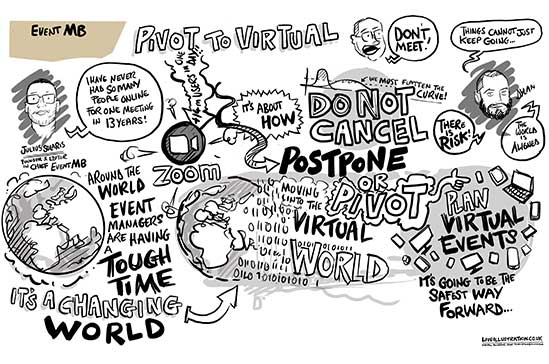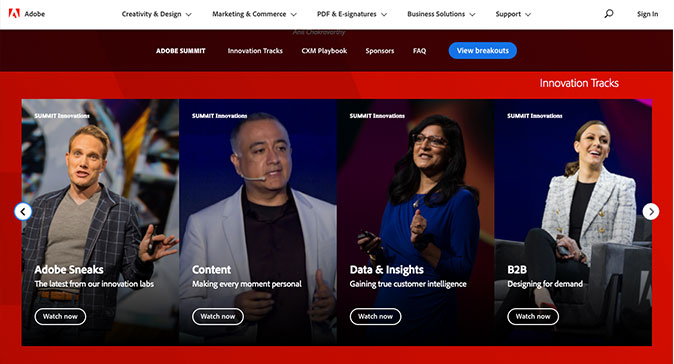Skift Take
While some planners are scrambling to figure out the saving grace that is virtual events, others are leading the way with novel virtual event ideas. Here are some original experiences and insights from recent online events to help inspire your own.
We need fresh virtual event ideas.
Virtual events are nothing new, but the industry has been slow to fully adopt them over the past few years — a live poll during EventMB’s recent Pivot to Virtual event showed that over 60% of planners who responded had never been involved in planning a virtual event.
With the outbreak of the coronavirus and stay-at-home orders around the world, virtual events have become the only way forward in the next few months — and likely into next year. This has forced many eventprofs to drastically shift their mindsets and planning processes to embrace the virtual format and everything that comes with it, including what may be unfamiliar tech, sponsorship opportunities, and networking options.
As more events pivot online and the industry focuses on delivering value in a virtual format, we’re starting to see a lot of creativity and innovation coming out of them. In this post, we’ve analyzed some recent online events (many of which were originally supposed to be in-person) in order to curate a list of ideas and best practices for your own upcoming virtual events.
Real-Time Illustrations During Sessions
Bringing artists on board to create real-time illustrations — known as digital live scribing — is a great way to engage your audience with a unique type of content. These talented illustrators create artwork live as panel discussions go on, providing a graphical representation of the speakers and takeaways that are entertaining, informative, and most importantly, widely shareable/postable.

Credits: Live graphic recording by Chris Shipton
– liveillustration.co.uk [email protected] – Twitter: @livepens
Our own deputy editor was immortalized in an illustration during our recent virtual event debut, Pivot to Virtual, and the artwork was also used in marketing materials for the subsequent report. Digital live scribing makes it easy to glean key insights from the sessions in a way that is fun to look at and, most importantly, extremely shareable.
#PivotToVirtual Loved this! Thank you for sharing your amazing talent with us! @EventMB pic.twitter.com/cOXKuxwgUV
— Tree-Fan Events || CMP & Productions (@TreeFan_Events) March 18, 2020
Live Games or Competitions
As part of Salesforce’s World Tour Sydney Reimagined virtual event, they implemented a live “battle of the apps” competition between exhibitors — complete with audience voting — called AppExchange Demo Jam.
During this session, Salesforce AppExchange partners were given three minutes each to do a live demo demonstrating their apps. The audience was then asked to vote for their favorite using a dedicated link that was accessible for 24 hours following the session, and the winner was announced on Twitter the next day.
Featuring sponsors and exhibitors through this kind of competition is a creative way to provide engaging demos while also getting the audience involved. Keeping the demos short and to-the-point is also beneficial considering that many attendees of virtual events will be facing more distractions while viewing at home, Plus, this kind of activity will have people checking back to and engaging with the event’s social media pages to see who won.
High-Production Value Content On Demand
Live streaming is often the backbone of virtual events, and it can be a very effective way to replace in-person presentations and sessions. However, there are other approaches that may work for your event, depending on your goals and the scale of the event. For example, Adobe decided to forego live streams for their recent Summit and went the prerecorded route instead.
What prerecorded sessions may lack in real-time engagement they make up for in production value, as they benefit from the ability to be edited or enhanced. This can greatly improve certain speakers’ performances. They also eliminate many common challenges of virtual events, such as planning around different time zones and connectivity issues during the event.

They also minimize people getting bored and tuning out of the live stream. Adobe uploaded the event’s content to their custom web platform on the day of the event, and from there, viewers were — and still are — able to choose to watch whatever sessions they wanted, whenever they wanted. This allowed each person to personalize their own experience and interact with the content that would bring them the most value on their own time.
Adobe’s event sessions are available online completely free of charge, which allows for maximum viewing. However, if you choose to charge for your event, you could also follow a similar format while implementing a paywall or registration page before granting attendees access to the content.
One thing to note if you decide to go this route is that, with people viewing the content on their own time, you’ll want to erect forums or schedule specific times for Q&As and networking sessions where people can connect about the topic and continue the dialogue.
AI-Generated Recommendations
Personalized video recommendations were another facet of Adobe’s event experience. As always, the capabilities of your virtual event will depend on the platform you’re using, and Adobe has the ability to create high-end experiences thanks to their in-house development teams and custom platform.
Taking a page out of the YouTube playbook, they incorporated custom content recommendations based on people’s behavior on the platform using Adobe’s Sensei AI engine. Personalizing content delivery in a virtual format in this way speaks to a much broader trend in events in general. Many are used to receiving personalized suggestions when consuming both content and products on the internet.
Making recommendations based on expressed interests or past behavior helps attendees get as much value as possible from the event.
Immersive Environments
While many virtual events are implementing virtual expo booths and networking tools, the SBC Digital Summit scheduled for next week will be taking these elements one step farther by designing their virtual space based on a physical conference center.
For example, the home screen from which attendees can access the different parts of the event is named Lobby and features a background of a convention center lobby. Similarly, the Networking Lounge feature looks like an actual lounge with chat windows that attendees can interact with.
Although not quite VR, these environments will allow attendees to feel familiar aspects of event spaces through the virtual format instead of just clicking through screens and videos that all look the same. Using design elements to give your event a unique look and feel will help set your event apart and serve to distinguish various spaces within the event as well.
Virtual Entertainment
Just because you’ve brought your event online doesn’t mean that you need to forego entertainment. Certain entertainment opportunities, such as musical performances, can translate very well to virtual events.
There have already been several entirely virtual concerts in the last few weeks, including the One World: Together at Home concert just this past weekend. The event was hosted by Global Citizen and the World Health Organization and was streamed on most major social media and streaming platforms.
The artists’ performances were prerecorded and then broadcast, which made sense for an event of this scale. For smaller affairs, including a live-streamed performance can add a special touch to your event.
EventMB’s next online event taking place April 30th, Managing the Virtual Experience, will include a musical performance by Benji Harris from SongDivision. People are missing concerts, shows, and countless other in-person experiences due to the pandemic, so incorporating a performance of some sort is a nice way to bring entertainment directly to them. Just like every other part of the industry, event entertainment companies are pivoting to virtual and can assist with bringing different types of entertainment to your online event.
Health and Wellbeing Activities
Online workout and dance videos are the only options for many people looking to exercise during this pandemic, and incorporating these types of activities into your event is a good way to switch things up and deliver unexpected value to attendees.
#MarTechFest Dial Up, which will be taking place next month, plans to include workout and meditation sessions throughout their event to get minds and bodies “ready to engage.”
#MarTechFest isn’t your average virtual event. We’ve got marketing’s best and brightest, networking bants and bangin’ hip hop beats. We’ll also be running workout and meditation sessions to get your mind and body ready to engage! https://t.co/tuEs99kXyU pic.twitter.com/coBjrUgAQ9
— MarTech Alliance (@MartechAlliance) April 20, 2020
Depending on the format of your event, you could organize a short workout or meditation break in between sessions, or have a separate stream for these kinds of activities that attendees can tune into throughout the event for a change of pace.
Intro Tutorial Video
It’s important to remember that while many eventprofs have never organized a virtual event and are unfamiliar with the inner workings of online conferences, many attendees may not be used to navigating and attending them and may need a little help.
Google SheetsCon, which was hosted on a custom event platform (as was Adobe’s), addressed this by including a short intro video for people to watch as they logged into the platform. This video acted as a brief tutorial that introduced attendees to the platform’s different features and instructed them on how to interact with the various pages.
Making sure everyone is comfortable with the platform and familiar with how the event will work is an important step in ensuring attendees take advantage of everything you’ve implemented and get the most value out of it.
Incentives to Engage Online
Giveaways are always a good way to increase engagement with attendees and can be a fun addition to a virtual event. Although it’s not quite as simple as handing an attendee their prize, there are virtual goodies you can offer, and there’s still the option of mailing physical incentives to attendees following the event.
As part of their event, Google SheetsCon hosted an incredibly popular contest to win one of 25 swag bags that they had put together with branded event shirts and stickers. In order to win, participants had to share something about the event on social media using the dedicated event hashtag, or visit at least 5 of the sponsor booth pages during the event. Using criteria like these helps increase brand awareness and also works to engage attendees, so it’s a win for everyone.
Uniting Behind a Common Purpose
When all Global Meetings Industry Day (GMID) events were cancelled this year, eventprofs rallied together to create a virtual event instead and aimed to break the world record for the most people in a virtual meeting. Although they didn’t quite succeed, they were able to get 12,500 people to join for the live webcast, which is still a major feat.
You don’t need to break a world record to use this approach. The extremely high participation in this event was partly due to the excitement of achieving something together. Collaboration and camaraderie are strong forces of engagement.
In keeping with the times, you could announce that you will be donating a certain amount to a healthcare organization or charity for every share or like you receive on social media.
Bonus: Announce Your Virtual Alternative When You Cancel Your Live Event
While not an idea for a virtual event per se, a best practice to keep in mind around the cancellation and postponement of events is to plan ahead and announce any virtual alternative that you’ll be organizing as soon as you announce the cancellation of the original event.
When the 2020 HIMSS Global Health Conference & Exhibition was cancelled, no alternative was proposed. The industry created its own replacement event, Virtual Health Conference 20. The official event has since announced its intention to organize a virtual edition of the conference, but no date has been announced, and it remains to be seen whether it will be impacted by the unofficial version that has already taken place. A community initiative and grassroots events organization also emerged after the cancellation of the Mobile World Congress in Barcelona, and the Tech Spirit Barcelona event rose up in its place.
By contrast, Salesforce planned ahead for a virtual replacement for their World Tour Sydney event in March and simply announced that the format of the event would be changing. The event’s live-stream drew over 80,000 attendees, so it was clearly successful in maintaining its audience through the transition.
While these grassroots events showcase the incredible resilience and motivation of event industry professionals, they are also important for planners to keep in mind so that they don’t risk losing their event to a faster-moving, unofficial alternative.
IN CONCLUSION
The age of virtual events is only beginning, and as they continue to take place — especially from major companies like Facebook and Microsoft that have now cancelled all live events through mid-2021 — there will undoubtedly be more innovation to look to for inspiration.
This year hasn’t turned out how anyone expected or hoped, but there’s still time to make the most of it and capitalize on virtual events. Use some of these ideas as guidance to continue delivering event experiences to attendees and stakeholders from the comfort of home.





